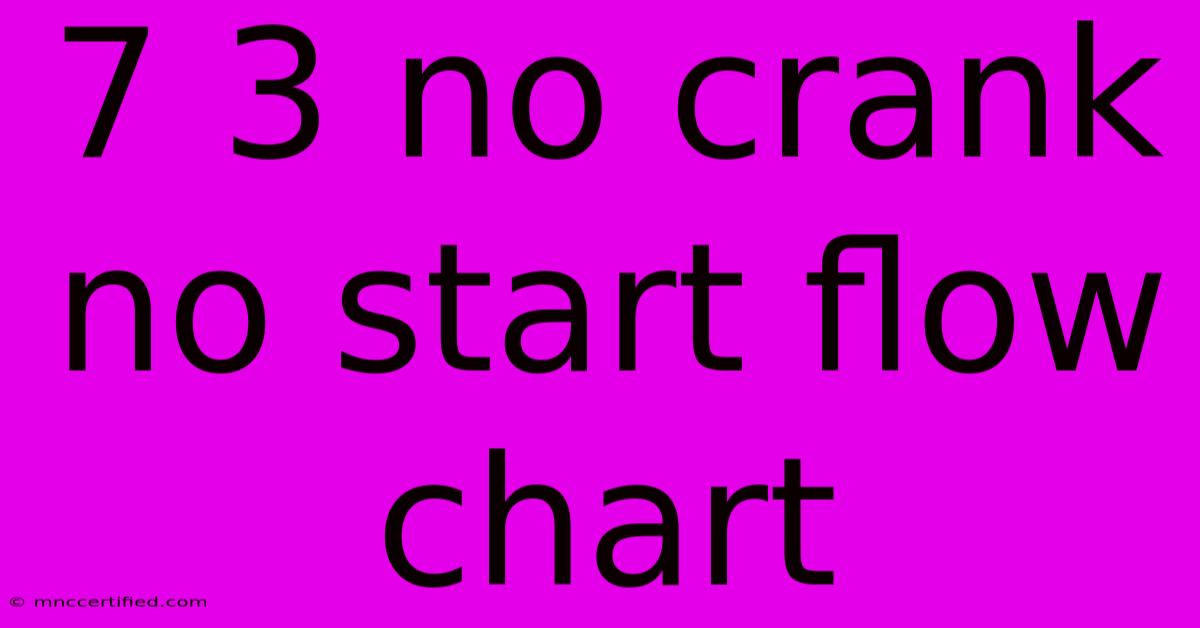7 3 No Crank No Start Flow Chart

Table of Contents
7.3 Power Stroke No Crank, No Start: A Comprehensive Troubleshooting Flowchart
A no-crank, no-start condition in your 7.3 Power Stroke diesel can be frustrating, but a systematic approach using a flowchart can help you diagnose the problem quickly and efficiently. This guide provides a detailed flowchart and explanations to help you get your truck back on the road. We'll cover common causes and how to troubleshoot them, saving you time and money on potentially unnecessary repairs.
Understanding the Problem: No Crank, No Start
A "no crank, no start" situation means your engine doesn't even attempt to turn over when you turn the key. This differs from a "no start" condition where the engine cranks but won't fire. This points to problems within the starting system itself, rather than fuel delivery or ignition.
The 7.3 Power Stroke No Crank, No Start Flowchart
This flowchart guides you through the diagnostic process:
graph TD
A[Turn the Key: Does Anything Happen?] --> B{Battery Voltage};
B -- Low Voltage (Below 10V) --> C[Check Battery, Cables, and Connections];
B -- Normal Voltage (12-14V) --> D{Ignition Switch};
C -- Problem Found --> E[Repair Battery/Cables/Connections];
C -- Problem Not Found --> F[Neutral Safety Switch];
D -- Faulty Switch --> G[Replace Ignition Switch];
D -- Functional Switch --> H{Starter Relay};
F -- Faulty Switch --> I[Replace Neutral Safety Switch];
F -- Functional Switch --> H;
H -- Faulty Relay --> J[Replace Starter Relay];
H -- Functional Relay --> K{Starter Motor};
K -- Faulty Motor --> L[Replace or Repair Starter Motor];
K -- Functional Motor --> M[Further Diagnostics Needed (PCM, Wiring, etc.)];
E --> A;
G --> A;
I --> A;
J --> A;
L --> A;
M --> N[Professional Mechanic Recommended];
N --> O[Repair/Replace as advised];
O --> A;
Explanation of Flowchart Steps:
- A. Turn the Key: Does Anything Happen? This is your starting point. Listen carefully for any clicks, buzzing sounds, or complete silence.
- B. Battery Voltage: Check the battery voltage using a multimeter. Low voltage indicates a battery problem, faulty connections, or a high-drain parasitic draw.
- C. Check Battery, Cables, and Connections: Inspect the battery terminals for corrosion, loose connections, and cable damage. Clean terminals and tighten connections. Consider a battery load test.
- D. Ignition Switch: The ignition switch sends power to the starter circuit. A faulty switch prevents power from reaching the starter.
- E. Repair Battery/Cables/Connections: Replace a faulty battery, repair or replace damaged cables, and ensure secure connections.
- F. Neutral Safety Switch: This switch prevents the starter from engaging unless the transmission is in Park or Neutral. A faulty switch can prevent starting.
- G. Replace Ignition Switch: If the ignition switch is faulty, it needs replacing.
- H. Starter Relay: The relay acts as a switch, allowing high current to flow to the starter motor. A faulty relay prevents the starter from receiving power.
- I. Replace Neutral Safety Switch: Replace a faulty neutral safety switch.
- J. Replace Starter Relay: Replace a faulty starter relay.
- K. Starter Motor: The starter motor is responsible for cranking the engine. A faulty starter can be internally damaged or have issues with its solenoid.
- L. Replace or Repair Starter Motor: Replace or have the starter motor repaired by a qualified mechanic.
- M. Further Diagnostics Needed (PCM, Wiring, etc.): If all the above steps check out, the problem could lie within the Powertrain Control Module (PCM), wiring harnesses, or other electrical components.
- N. Professional Mechanic Recommended: At this point, expert diagnosis is necessary.
- O. Repair/Replace as advised: Follow the mechanic's recommendations for repair or replacement.
Important Considerations for 7.3 Power Strokes:
- Glow Plugs: While not directly related to a no-crank condition, ensure your glow plugs are functioning correctly, especially in cold weather. A failure to glow can lead to hard starting, but not a no-crank situation.
- Security Systems: Check your vehicle's security system; a fault might prevent the starter from engaging.
- Wiring Harness: Damaged wiring, especially around the starter, can be a significant cause of no-crank issues.
Keyword Optimization and On-Page SEO
This article targets the following keywords and variations:
- 7.3 Power Stroke no crank no start
- 7.3 Power Stroke troubleshooting
- 7.3 diesel no crank
- Ford 7.3 no start
- No crank no start diagnosis
- 7.3 Power Stroke starting problems
- 7.3 Power Stroke electrical problems
These keywords are naturally integrated throughout the text, enhancing its search engine optimization.
By carefully following this flowchart and understanding the potential causes, you can effectively troubleshoot your 7.3 Power Stroke's no-crank, no-start issue. Remember to always prioritize safety and seek professional help when needed. Good luck!

Thank you for visiting our website wich cover about 7 3 No Crank No Start Flow Chart. We hope the information provided has been useful to you. Feel free to contact us if you have any questions or need further assistance. See you next time and dont miss to bookmark.
Featured Posts
-
Fortnite 32 11 Juice Wrld Skin Catty Corner
Nov 21, 2024
-
Auto Insurance In Bakersfield Ca
Nov 21, 2024
-
Tanner Insurance Pearson Georgia
Nov 21, 2024
-
Home Insurance San Bernardino Ca
Nov 21, 2024
-
Loggerhead Insurance Agent Login
Nov 21, 2024